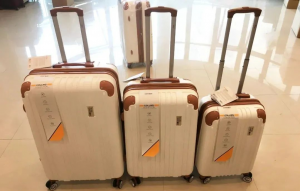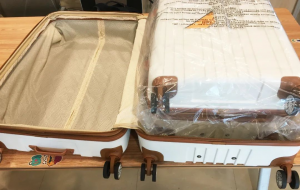Travel bags are usually only used when going out. If the bag breaks while you are out, there is not even a replacement. Therefore, travel luggage must be easy to use and sturdy. So, how are travel bags inspected?

Our country's current relevant luggage standard QB/T 2155-2018 makes relevant specifications for the product classification, requirements, test methods, inspection rules, marking, packaging, transportation and storage of suitcases and travel bags. Suitable for all kinds of suitcases and travel bags that have the function of carrying clothing and are equipped with wheels and trolleys.
1. Specifications
1.1 Suitcase
Product specifications and allowable deviations should comply with regulations.
1.2 Travel bag
For various travel bags equipped with wheels and pull rods, the product specifications should comply with the design regulations, with an allowable deviation of ±5mm.
2. Box (bag) locks, wheels, handles, pull rods, hardware accessories, and zippers comply with relevant regulations.
Under natural light, use your senses and a measuring tape to check. The graduation value of the measuring tape is 1mm. The box opening joint gap is measured with a feeler gauge.
3.1 Box (package body)
The body is correct and the teeth are straight; upright and stable, without any unevenness or crookedness.
3.2 Box noodles (bread noodles)
3.2.1 Soft cases and travel bags
The surface material has a consistent color and luster, and there are no obvious wrinkles or bows in the suture area. The overall surface is clean and free of stains. The surface material of leather and regenerated leather has no obvious damage, cracks or cracks; the surface material of artificial leather/synthetic leather has no obvious bumps or marks; the main parts of the surface material of fabric have no broken warp, broken weft or skipped yarn. , cracks and other defects, only 2 minor defects are allowed in minor parts.
3.2.2 Hard case
The surface of the box has no defects such as unevenness, cracks, deformation, burns, scratches, etc. It is overall clean and free of stains.
3.3 Box mouth
The fit is tight, the gap between the bottom of the box and the cover is no more than 2mm, the gap between the cover box and the cover is no more than 3mm, the box mouth and the box top are assembled tightly and squarely. Smashes, scratches, and burrs are not allowed on the aluminum opening of the box, and the protective layer on the metal surface must be consistent in color.
3.4 In the box (in the bag)
The stitching and pasting are firm, the fabric is neat and tidy, and the lining has no defects such as cracked surface, broken warp, broken weft, skipped yarn, split pieces, loose edges and other defects.
3.5 Stitches
The stitch length is even and straight, and the upper and lower threads match. There are no empty stitches, missing stitches, skipped stitches, or broken threads in key parts; two minor parts are allowed, and each place must not exceed 2 stitches.
3.6 Zipper
The sutures are straight, the margins are consistent, and the error is no more than 2mm; the pulling is smooth, with no misalignment or missing teeth.
3.7 Accessories (handles, levers, locks, hooks, rings, nails, decorative parts, etc.)
The surface is smooth and burr-free. The metal plating parts are evenly coated, with no missing plating, no rust, no blistering, peeling, and no scratches. After the spray-coated parts are sprayed, the surface coating will be uniform in color and without spray leakage, dripping, wrinkling or peeling.

1. Fatigue resistance of tie rod
Inspect according to QB/T 2919 and pull together 3000 times. After the test, there was no deformation, jamming, or loosening of the tie rod.
When testing a double-tie suitcase, all tie-rods should be pulled out and a load of 5kg should be applied to the expansion joint connecting the tie-rods to the box. After the test, the running wheel rotates flexibly, without jamming or deformation; the wheel frame and axle have no deformation or cracking; the running wheel wear is not more than 2mm; the tie rod pulls smoothly, without deformation, looseness, or jamming, and the tie rod and side pull belt There is no cracking or looseness at the joint between the side mop and the box; the box (bag) lock is opened normally.
3. Oscillation impact performance
Place the load-bearing objects evenly in the box (bag), and test the handles, pull rods, and straps in sequence according to regulations. The number of oscillation impacts is:
——Handles: 400 times for soft suitcases, 300 times for hard cases, 300 times for side handles; 250 times for travel bags.
- Pull rod: when the suitcase size is ≤610mm, pull the rod 500 times; when the suitcase size is >610mm, pull the rod 300 times; when the travel bag pull rod is 300 times
Second-rate. When testing the pull rod, use the suction cup to move up and down at a constant speed without releasing it.
——Sling: 250 times for single strap, 400 times for double strap. When testing the strap, the strap should be adjusted to its maximum length.
After the test, the box (package body) has no deformation or cracking; the components have no deformation, breakage, damage, or disconnection; the fixings and connections are not loose; the tie rods are pulled together smoothly, without deformation, looseness, or jamming. , not disjointed; there is no cracking or looseness at the joint between the tie rod and the box (package body); the box (package) lock is opened normally, and the password lock has no jamming, number skipping, unhooking, garbled numbers and out-of-control passwords.
Adjust the height of the release platform to the point where the bottom of the specimen is 900mm away from the impact plane.
——Suitcase: drop once each with the handle and side handles facing upward;
——Travel bag: Drop the surface equipped with the pull rod and the running wheel once (horizontally and once vertically).
After the test, the box body, box mouth, and lining frame will not crack, and dents are allowed; the running wheels, axles, and brackets will not break; the gap between the bottom of the matching box and the cover will not be greater than 2mm, and the gap between the cover box joints will not be greater than 3mm; the running wheel will rotate Flexible, no loosening; fasteners, connectors, and locks are not deformed, loose, or damaged; box (package) locks can be opened flexibly; there are no cracks on the box (package) surface.
5. Static pressure resistance of the hard box
Lay the empty hard box flat, with the test area on the box surface 20mm away from the four sides of the box surface. Place the load-bearing objects evenly to the specified load (so that the entire box surface is evenly stressed). The load-bearing capacity of the hard box with specifications of 535mm ~ 660mm (40±0.5 ) kg, the hard box of 685mm ~ 835mm can bear a load of (60±0.5) kg, and be continuously pressurized for 4 hours. After the test, the box body and mouth did not deform or crack, the box shell did not collapse, and it opened and closed normally.
6. The impact resistance of the fine material hard box surface from falling balls
Use a (4000±10)g metal weight. There was no cracking on the box surface after the test.
7. Roller impact performance
The metal roller should not be equipped with a cone. After the sample is placed at room temperature for more than 1 hour, it is directly placed into the roller and rotated 20 times (not applicable to metal hard boxes). After the test, the box, box mouth, and lining are not cracked, and dents are allowed, and the anti-scratch film on the surface of the box is allowed to be damaged; the running wheels, axles, and brackets are not broken; the running wheels rotate flexibly without loosening; the pull rods are pulled smoothly and without any loosening. Jamming; fasteners, connectors, and locks are not loose; box (package) locks can be opened flexibly; the length of a single break of the soft box teeth and strips shall not be greater than 25mm.
8. Durability of box (bag) lock
After inspection in accordance with the provisions of Articles 2, 3, 4, and 7 above, the durability of the luggage lock of the product shall be manually inspected. Opening and closing shall be counted as one time.
——Mechanical password lock: Set the password by dialing the password wheel by hand, and use the set password to open and close the password lock. Combine the digits at will, and test on and off 100 times respectively.
——Key lock: Hold the key with your hand and insert it into the key slot of the lock cylinder along the lock cylinder to open and close the lock.
——Electronically coded locks: use electronic keys to open and close locks.
——The mechanical combination lock is opened and tested with any 10 different sets of garbled codes; the key lock and electronic coded lock are opened and tested 10 times with a non-specific key.
The box (bag) lock can be opened and closed normally, with no abnormalities.
9. Box aluminum mouth hardness
Not less than 40HWB.
10. Suture strength
Cut a sample of the stitched fabric from any part of the main stitching surface of the soft box or travel bag. The effective area is (100±2) mm × (30±1) mm [sew line length (100±2) mm, suture line The fabric width on both sides is (30±1) mm], the upper and lower clamps have a clamping width of (50±1) mm, and a spacing of (20±1) mm. Tested with a tensile machine, the stretching speed is (100±10) mm/min. Until the thread or fabric is broken, the maximum value displayed by the tensile machine is the stitching strength. If the value displayed by the tensile machine exceeds the specified value of stitching strength and the sample does not break, the test can be terminated.
Note: When fixing the sample, try to keep the center of the suture line direction of the sample at the center of the upper and lower clamp edges.
The stitching strength between the surface materials of soft boxes and travel bags shall not be less than 240N on the effective area of 100mm×30mm.
11. Color fastness to rubbing of travel bag fabrics
11.1 For leather with surface coating thickness less than or equal to 20 μm, dry rubbing ≥ 3 and wet rubbing ≥ 2/3.
11.2 Suede leather, dry rub ≥ 3, wet rub ≥ 2.
11.2 For leather with a surface coating thickness greater than 20 μm, dry rubbing ≥ 3/4 and wet rubbing ≥ 3.
11.3 Artificial leather/synthetic leather, regenerated leather, dry rub ≥ 3/4, wet rub ≥ 3.
11.4 Fabrics, uncoated microfiber materials, denim: dry wipe ≥ 3, wet wipe is not inspected; others: dry wipe ≥ 3/4, wet wipe ≥ 2/3.
12. Corrosion resistance of hardware accessories
According to the regulations (excluding tie rods, rivets, and metal chain elements), the zipper head only detects the pull tab, and the test time is 16 hours. The number of corrosion points shall not exceed 3, and the area of a single corrosion point shall not exceed 1mm2.
Note: a Metal hard cases and travel bags are not inspected for this item.
b Not suitable for special style materials.
c Common leather varieties with surface coating thickness less than or equal to 20 μm include water-dyed leather, aniline leather, semi-aniline leather, etc.
Post time: Dec-08-2023





